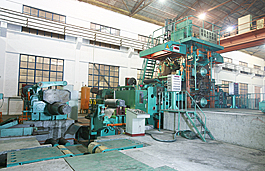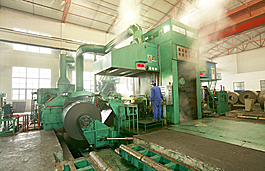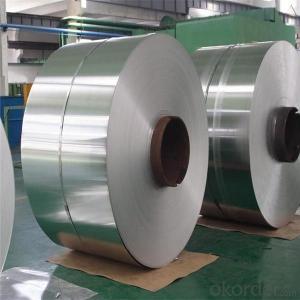Stainless Steel Coil Price Per Ton 321 Quality
- Loading Port:
- Shanghai
- Payment Terms:
- TT OR LC
- Min Order Qty:
- 4 m.t.
- Supply Capability:
- 50000 m.t./month
OKorder Service Pledge
OKorder Financial Service
You Might Also Like
Item specifice
Thickness | 0.1 mm-100mm |
Width | 1000mm, 1219mm, 1240mm, 1500mm, 1800mm, 2000mm |
Length | 2000mm-6000mmor as customer request |
Standard | ASME, ASTM, EN, BS, GB, DIN, JIS, etc |
Material | 201, 202, 301, 321, 304, 304L, 316, 316L, 309S, 310S, 410, 430, etc |
Surface | 2B, BA, 8K, No. 4 No.1 |
Mill: | TISCO, LISCO, BAO STEEL |
Packaging | Standard export sea-worthy packing |
Technique | Hot rolled / cold rolled |
Delivery time | 10-25days |
Supply ability | 700 metric tons/ month |
Payment terms | L/C, T/T |
Application range | Foodstuff, gas, metallurgy, biology, electron, chemical, petroleum, boiler, nuclear energy Medical equipment, fertilizer, etc. |
Note | We can produce other standard as the customers' requirement |




Packaging & Shipping

Our Services

- Q:What is the difference between cold rolled and hot rolled stainless steel strips?
- Cold rolled and hot rolled stainless steel strips differ in their manufacturing processes and resulting properties. Cold rolled stainless steel strips are produced by passing the stainless steel through a series of rollers at room temperature. This process results in a thinner and more precise strip with a smooth and shiny surface finish. Cold rolling also increases the strength and hardness of the stainless steel, making it suitable for applications that require high strength and a polished appearance. Additionally, cold rolled stainless steel strips have better dimensional accuracy and straightness compared to their hot rolled counterparts. On the other hand, hot rolled stainless steel strips are manufactured by heating the stainless steel slab or billet to a high temperature and then rolling it through a series of rolling mills. This process produces a thicker and less precise strip with a rough and scaled surface finish. Hot rolling is preferred for applications that do not require a high level of precision or a polished appearance, such as structural applications or manufacturing processes that involve further shaping or forming of the stainless steel strip. In terms of properties, cold rolled stainless steel strips have higher tensile strength and yield strength compared to hot rolled strips. They also exhibit better corrosion resistance, as the cold rolling process helps to refine the microstructure of the stainless steel, reducing the presence of defects and impurities. However, hot rolled stainless steel strips have higher ductility and are more easily formable due to their higher temperature processing. Overall, the choice between cold rolled and hot rolled stainless steel strips depends on the specific application requirements, such as the desired surface finish, dimensional accuracy, strength, and formability.
- Q:Can stainless steel strips be used in marine applications?
- Yes, stainless steel strips can be used in marine applications. Stainless steel is known for its corrosion resistance, making it an ideal material for marine environments where it is constantly exposed to saltwater and moisture. Stainless steel strips are often used in marine applications such as boat hardware, marine fittings, and structural components. They are designed to withstand the harsh conditions of the sea, including high levels of salt, humidity, and UV exposure. Additionally, stainless steel strips offer excellent strength and durability, ensuring they can withstand the demanding conditions of marine environments over an extended period of time.
- Q:Can stainless steel strips be used in the chemical manufacturing industry?
- Yes, stainless steel strips can be used in the chemical manufacturing industry. Stainless steel is known for its excellent corrosion resistance properties, making it highly suitable for use in environments where chemicals are present. Stainless steel strips are often used in the construction of chemical processing equipment such as tanks, reactors, and piping systems. The material's resistance to corrosion helps prevent contamination of the chemicals being processed, ensuring the integrity and purity of the final product. Stainless steel strips are also resistant to high temperatures and can withstand the harsh conditions often found in chemical manufacturing processes. Additionally, stainless steel is easy to clean and maintain, making it a cost-effective and long-lasting choice for the chemical industry.
- Q:Can stainless steel strips be used in solar energy systems?
- Yes, stainless steel strips can be used in solar energy systems. Stainless steel is a durable and corrosion-resistant material, making it suitable for outdoor applications. It can be used in solar panels, mounting frames, and other components of solar energy systems to provide structural support and longevity.
- Q:Are stainless steel strips magnetic?
- Yes, stainless steel strips can be magnetic or non-magnetic, depending on the specific type of stainless steel used. Stainless steel is an alloy that contains iron, which is inherently magnetic. However, the addition of certain elements such as nickel or manganese can alter the magnetic properties of stainless steel. Stainless steel strips that have a higher nickel content, such as the popular 304 or 316 grades, are generally non-magnetic. On the other hand, stainless steel strips with lower nickel content, such as the 400 series, can be magnetic. Therefore, it is important to consider the specific grade and composition of the stainless steel strip when determining its magnetic properties.
- Q:What industries use stainless steel strips?
- Stainless steel strips are widely used in various industries due to their excellent properties and versatility. Some of the industries that extensively utilize stainless steel strips include: 1. Automotive Industry: Stainless steel strips are used in the manufacturing of automotive components, such as exhaust systems, trim, and decorative parts. The corrosion resistance, strength, and durability of stainless steel make it ideal for these applications. 2. Construction Industry: Stainless steel strips are commonly used in the construction sector for structural and architectural purposes. They are used in the fabrication of building facades, handrails, cladding, roofing, and reinforcement bars due to their high strength, corrosion resistance, and aesthetic appeal. 3. Aerospace Industry: Stainless steel strips find applications in the aerospace industry where they are used in the production of aircraft components, such as engine parts, exhaust systems, structural elements, and fasteners. Stainless steel's resistance to high temperatures and harsh environmental conditions makes it suitable for this industry. 4. Food and Beverage Industry: Stainless steel strips are extensively used in the food and beverage industry due to their hygienic and corrosion-resistant properties. They are used in the manufacturing of food processing equipment, storage tanks, conveyor systems, and kitchen appliances. 5. Medical and Pharmaceutical Industry: Stainless steel strips are crucial in the medical and pharmaceutical industry due to their excellent biocompatibility, corrosion resistance, and ease of sterilization. They are used in the production of surgical instruments, medical devices, implants, and pharmaceutical equipment. 6. Chemical Industry: Stainless steel strips are widely used in the chemical industry for their resistance to corrosion caused by various chemicals and high temperatures. They find applications in the production of chemical processing equipment, storage tanks, pipes, and valves. 7. Energy Industry: Stainless steel strips are utilized in the energy sector for various applications, including power generation, oil and gas exploration, and renewable energy production. They are used in the manufacturing of turbines, heat exchangers, pipelines, and offshore platforms due to their durability and resistance to corrosion. 8. Electronics Industry: Stainless steel strips are commonly used in the electronics industry for their excellent electrical conductivity and thermal properties. They find applications in electronic components, connectors, and shielding materials. Overall, the versatility, corrosion resistance, strength, and aesthetic appeal of stainless steel strips make them indispensable in numerous industries, ranging from automotive and construction to aerospace, medical, and beyond.
- Q:Why does stainless steel carry magnetism?
- If you go to the molten steel and high chromium nickel austenitic steel, tempered magnet is not stainless steel. If the molten steel in the main alloy elements is chromium, iron and carbon and a small amount of nickel (or without nickel), tempered steel is a magnet on the stainless steel, also called ferritic stainless steel martensitic stainless steel or austenitic stainless steel. In addition to the magnet is not on, ferrite, martensite stainless steel are magnetic. The nickel element in the reserves in the world is very few, the price is more expensive, therefore, high nickel content in stainless steel on the market price is higher, and the magnet suction is not at present because of austenitic stainless steel for stainless steel in the proportion is still great, so that people have a misconception of all stainless steel are non-magnetic.
- Q:Are stainless steel strips suitable for architectural cladding?
- Yes, stainless steel strips are suitable for architectural cladding. Stainless steel is highly durable, corrosion-resistant, and has a sleek and modern appearance. It can be used to create a variety of design elements for architectural cladding, such as panels, screens, and facades. Additionally, stainless steel is easy to maintain and can withstand harsh weather conditions, making it an ideal choice for long-lasting and visually appealing architectural cladding.
- Q:Can stainless steel strips be used in wastewater treatment plants?
- Yes, stainless steel strips can be used in wastewater treatment plants. Stainless steel is a highly durable and corrosion-resistant material, making it suitable for use in environments with high moisture and chemical exposure, such as wastewater treatment plants. Stainless steel strips can be utilized in various applications within the plant, including piping, tanks, screens, and other equipment. Additionally, stainless steel's resistance to bacterial growth and ease of cleaning makes it a hygienic choice for use in the treatment of wastewater.
- Q:Can stainless steel strips be used in chemical processing industries?
- Yes, stainless steel strips can be used in chemical processing industries. Stainless steel is highly resistant to corrosion and can withstand extreme temperatures, making it an ideal material for chemical processing applications. It is commonly used in the construction of tanks, piping systems, heat exchangers, and other equipment that come into contact with corrosive chemicals. Stainless steel strips are often used for fabricating these components due to their versatility and ability to be easily formed into different shapes and sizes. Additionally, stainless steel is known for its hygienic properties, making it suitable for industries that require strict cleanliness and sanitation standards. Overall, stainless steel strips are a reliable and durable choice for chemical processing industries.
1. Manufacturer Overview |
|
|---|---|
| Location | |
| Year Established | |
| Annual Output Value | |
| Main Markets | |
| Company Certifications | |
2. Manufacturer Certificates |
|
|---|---|
| a) Certification Name | |
| Range | |
| Reference | |
| Validity Period | |
3. Manufacturer Capability |
|
|---|---|
| a)Trade Capacity | |
| Nearest Port | |
| Export Percentage | |
| No.of Employees in Trade Department | |
| Language Spoken: | |
| b)Factory Information | |
| Factory Size: | |
| No. of Production Lines | |
| Contract Manufacturing | |
| Product Price Range | |
Send your message to us
Stainless Steel Coil Price Per Ton 321 Quality
- Loading Port:
- Shanghai
- Payment Terms:
- TT OR LC
- Min Order Qty:
- 4 m.t.
- Supply Capability:
- 50000 m.t./month
OKorder Service Pledge
OKorder Financial Service
Similar products
New products
Hot products
Hot Searches
Related keywords






























